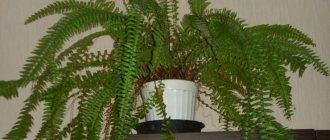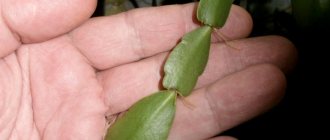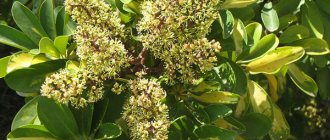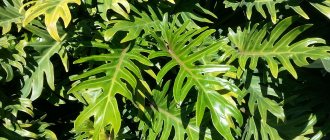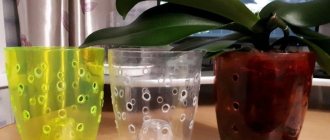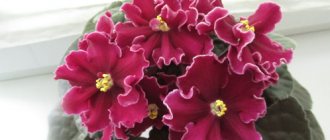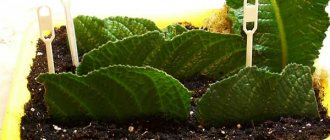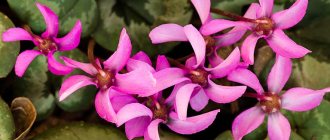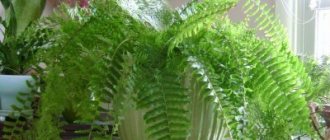Home — Botany — Houseplants — How ferns reproduce
Ferns are the most ancient plants that have grown on Earth since ancient times. There are approximately 11 thousand species of ferns in the world. In home floriculture, plants are used for their beautiful leaves. They don't bloom. Tropical and subtropical plants are grown indoors; bushes from temperate latitudes are used for planting outdoors.
The plant's rich hair compensates for the lack of flowers.
Reproduction
Sporangia are located on the underside of the leaf, collected in groups (soruses). The sori are covered from above by a veil (ring). The spores are dispersed when the wall of the sporangium ruptures, and the ring, detached from the thin-walled cells, behaves like a spring. The number of spores on one plant reaches tens, hundreds of millions, sometimes billions.
Fern leaf from the underside
On moist soil, the spores germinate into a small green heart-shaped plate a few millimeters in size. This is a prothallus (gametophyte). It is located almost horizontally to the surface of the earth, attached to it by rhizoids. The prothalla is bisexual. On the underside of the prothallus, female and male reproductive organs are formed (male - antheridia, female - archegonia).
Fertilization occurs in an aquatic environment (during dew, rain or under water).
Male gametes - sperm swim up to the eggs, penetrate inside and the gametes fuse.
Fertilization occurs, resulting in the formation of a zygote (fertilized egg).
From the fertilized egg, a sporophyte embryo is formed, consisting of a haustorium - a leg with which it grows into the tissue of the prothallus and consumes nutrients from it, an embryonic root, a bud, and the first leaf of the embryo - “cotyledons”.
Over time, a fern plant develops from the shoot.
Fern development diagram
Thus, the gametophyte
ferns exist independently of the sporophyte and are adapted to living in humid conditions.
Sporophyte
is the entire plant that grows from a zygote - a typical land plant.
Ferns belong to the oldest group of plants, which existed long before the appearance of flowering vegetation and have survived to this day. Today, fern is one of the popular plants for landscape design. In this topic, we will consider the propagation of ferns at home, as well as their varieties and development.
Scheme and description of plant propagation
Fern propagation occurs through seeds.
The fern propagation scheme occurs in this way: on the underside of the fern leaf there are sori, which, when ripe, are separated from the leaf blade. The sporangia in the sorus ring rupture, scattering the fern spores around them. The spore then forms a small green plate that grows into the soil. This shoot is attached to the soil by rhizodes and has male and female plant genital organs. As soon as water gets on the plate, for example, after rain, fertilization occurs: in the female organs (archegonia) there is an egg, to which sperm move from the male organs (antheridia) drop by drop of water, and fertilize it. The result is a full-fledged embryo attached to the prothallus, from which it feeds during development. Then, over time, the plant grows.
Types and varieties of ferns
There are a huge number of groups and varieties of fern.
Asplenium.
Known for its love of rocky surfaces. Forms a separate family. The description is as follows: round, leathery leaf blades on thin branches. The most famous two types: wall and northern. The first is often found on the walls of old stone buildings. It grows mainly in rock crevices. Northern loves the rocky places of northern Europe and Asia.
Woodsia.
Belongs to the Asplenieceae family. A low-growing fern, characterized by “fluffy” foliage - thin leaves grow from a small root, from which smaller leaves diverge in two directions. It has several varieties (Elbe, multi-row), which differ in the size and density of the leaves.
Kochedyzhnik.
Also belongs to the Asplenium family. This variety has about 200 varieties. Of these, the most famous are female, Chinese-reddish (with red veins). Description: tall shrub with delicate, light leaf feathers.
Multi-row.
Like previous groups, it is part of the Asplenium family. It differs from the previous ones in the width of its leafy branches and its love for the dense shade of wooded areas. The following varieties are known: Brown's multirow, tripartite, and bristle.
Orlyak.
Belongs to the Cyathea family. Popular for its unpretentiousness - varieties of this group are found on all continents of our planet: tundra, wasteland, wooded thickets. It is not found except in the desert and steppes. It differs from other varieties in the huge size of its leaf branches - up to one and a half meters.
Osmunda.
Forms his own family. One of the most ancient types of ferns. In ancient times they grew on all continents, but today they are found only in the Caucasus, in the forests of East Asia and North America. The following varieties are known: Asian, Clayton, royal. Loves a little shade and marshy areas.
Many indoor plants have such a decorative appearance that they seem artificial. If you want to have a real “corner of the forest” at home, you should acquire one of the most ancient plants, the ancestors of which date back to the dinosaurs - fern. Its external attractiveness and undemanding nature have earned this plant the love of flower growers. And now we have an indoor fern, caring for it at home is not difficult.
How ferns reproduce by spores
This method is most effective in the spring after the soil has warmed up. Sowing in a pot is done in autumn or early spring.
How fern reproduces using spores at home:
- Moisten the soil with a spray bottle.
- Sprinkle spores on top.
- Sprinkle a 3-centimeter layer of soil on top.
- Cover the top with glass or plastic containers, since it is necessary to create a greenhouse effect.
- When sprouts appear, you will need to remove the cover every day for 2 hours.
Indoor fern: care at home
The most common fern in Russian homes is Nephrolepis. It easily adapts to room conditions and looks impressive. Rich green color, elegant rosette, carved leaves - up to half a meter long. Even if the fern is the only plant in the house, after a while it will grow so much that it will look like a piece of the garden and will begin to attract the attention of guests. But in order for the fern to thrive, a number of conditions must be met.
Soil requirements
It would seem, what could be the care for a fern growing in the forest shade? Who waters it, fertilizes it, carefully grows it? But no, there are demands, and quite a lot.
First of all, it is worth remembering that it is the forest soil that flower growers go for, trying to provide their plants with the best soil.
What kind of land is in the forest? Fertile, peaty and light. That is, there are enough nutrients in it, and the water does not stagnate. If you have purchased a fern and are going to replant it, then you can add a little rotted foliage or old pine needles to the soil purchased in the store. No matter how much the fern loves dampness, stagnation of moisture is strictly contraindicated for it. Store-bought soil “cakes” over time and becomes dense, so adding foliage will be very helpful.
Is it possible to grow ferns from seeds?
Under no circumstances should fern spores be confused with seeds. Planting material is prepared independently. As soon as sporangia form on the lower leaves, trim several branches. The spore sacs will not have time to open, and when they ripen, they will be ready for drying. The seeds are removed from the sheets and dried under gauze in a room with low humidity. Fern propagation by seeds begins in mid-March or late April.
Seeds are planted in the ground when they can be crushed to the touch. The method of growing shrubs is almost no different from spore growing, except that the spores do not always germinate and most of the planting material dies at the stage of development to prothallium. In the first 2-3 months, watering is carried out 1-2 times a week. The minimum temperature for planting outdoors is allowed up to + 10 ° C, in the room up to + 15-18 ° C. At the age of 6 months, they are transplanted into new soil and fed with phosphates. At the age of 1-2 years, the bushes are divided into seedlings.
Basic methods
Every gardener knows that indoor flowers can be propagated by seeds, cuttings, shoots, bulbs, division of rhizomes and other equally popular methods. Not everyone knows how fern reproduction occurs. Let's figure out how and how ferns reproduce.
There are two types of ferns: asexual (sporophytes) and sexual (gametophytes). In home floriculture, sporophytes are grown, in which the leaf blade is usually curled into a spiral. Asexual reproduction of ferns can be carried out by dividing the bush, sowing spores, lateral shoots and brood buds.
So, we bring to your attention the most common methods of fern propagation among lovers of indoor flora.
Disputes
According to many gardeners, propagation of ferns by spores is one of the most complex and labor-intensive processes. On the inside of adult leaf blades you can find brownish dust - these are spores. The spores will serve as a kind of seeds for the propagation of a tropical flower.
Take a plastic bag and collect the spores in it. Pour a mixture of sand and crushed peat into a plastic container and distribute the spores evenly over the entire surface of the soil. Don't forget to moisten the soil well. To create a favorable microclimate, the container must be covered with glass.
After 1–1.5 months, the first shoots will appear in the form of thick, bright green moss. As soon as the first leaves begin to hatch, you can open the container.
Young plants can be planted when three leaves are formed on each stem.
Dividing the bush
It will not be difficult to propagate a fern by dividing the bush if you first familiarize yourself with the advice and help of experienced gardeners. Before you start replanting an indoor flower, you should carefully examine it. In order for the bush to be divided into several fragments, each part must have a root system and 2-3 rosettes. There is no point in dividing a bush with one rosette, since single rosettes do not take root.
Upon completion of the division of the rhizome, each fragment is planted in a separate flower pot. Don't forget to monitor soil moisture and air temperature. For quick and good rooting, it is necessary to adhere to a temperature regime in the range of +18…+22 °C. Over-dried soil, low air humidity, too low or, conversely, high air temperature in the room will lead to the death of the transplanted ferns.
Vegetatively
Vegetative methods include propagation by lateral buds and shoots. But these methods of growing indoor flowers are not suitable for all varieties of fern. For example, propagation by brood buds is often used in the process of growing bladderwort, adiantum, doryopteris digitata, etc.
How to grow fern from brood buds, you ask? Let's consider this method step by step.
Carefully remove the buds on which roots have formed from the leaves. Place the collected material in a special container covered with glass. It is important to maintain a high level of humidity inside and an air temperature of about +24 °C. It is recommended to replant into separate containers only when the young shoots are well established and new leaves begin to form on them.
The shoots, which are long arrows on the leaves of the fern, are also used for propagation. Take a container with nutritious soil, place it next to the flower, bend the shoot to the soil and fix it.
It is necessary to separate the shoot from the mother plant after 1–1.5 months, when its roots have formed.
Ferns (Polypodiophyta)
, or
pteridophytes
, are spore-bearing terrestrial plants with strongly dissected, feathery leaves. They live on land in shady places, some in water. They spread by spores. They reproduce asexually and sexually. Fertilization in ferns occurs only in the presence of water.
In shady forests and damp ravines, ferns grow - herbaceous plants, and less often - trees, with large, strongly dissected leaves.
Ferns are widespread throughout the globe. They are most numerous and diverse in Southeast Asia. Here, ferns completely cover the soil under the forest canopy and grow on tree trunks.
Ferns grow both on land and in water. Most are found in moist, shady areas.
All ferns have a stem, roots and leaves. The strongly dissected leaves of ferns are called fronds. The stem of most ferns is hidden in the soil and grows horizontally (Fig. 80). It is unlike the stem of most plants and is called a rhizome.
How and when to divide a bush
One of the most effective and shortest vegetative methods of propagation of club mosses is the division of an adult bush. Before carrying out this procedure, it is necessary to water the bush generously with water at room temperature in order to easily pull it out of the ground without damaging the root system.
How to propagate indoor fern by dividing the bush:
- Dig holes 40-60 centimeters deep in advance. Their bottom is covered with drainage material, and the top is sprinkled with soil mixture.
- Pull the plant out of the old soil and divide it into several equal parts.
- Each of them is planted in a separate hole or pot.
Thorough root watering is carried out once a week and watered from above twice using a watering can.
Important! You cannot divide a young bush with one root rosette.
Spores on the underside of leaves
Fern propagation
Spore plants differ from seed plants in many properties associated with reproduction. For example, in seed plants, the seeds are already fertilized when they fall into the ground, and a plant similar to the mother specimen immediately grows from them. This is not the case with ferns. Spores, which in a large number of fern species are formed under the green leaves, fall into the ground and develop into small green sprouts that are completely different from the mother plant. These shoots are called gametophytes. Gametophytes are female and male, and from them special cells, gametes, are formed in the ground. Male gametes combine with female ones, and at the site of their union a new form of fern begins to form, which is called a sporophyte.
Gametophytes are very small in size, and we do not see them in nature. What we notice in forests, or what is sold as an ornamental plant, is already the sporophytic phase of the fern. Sporophytes are often perennial. In hot climatic zones of the world, sporophytes are evergreen, but in temperate and more northern zones they shed their terrestrial green part in winter.
Ferns are distributed virtually throughout the globe, from deserts to swamps, rice fields and brackish ponds. They are most diverse in tropical rainforests. There they are represented by both tree-like forms (up to 25m in height) and herbaceous and epiphytic forms (growing on tree trunks and branches). There are species of ferns only a few millimeters long.
How to propagate fern using brood buds
Another vegetative way by which a fern can reproduce at home is by planting formed buds on the leaves in the ground. Fern-like plants have the ability to grow lateral shoots on the petioles of their leaf blades. You cannot plant an unformed bud; it must produce small roots.
Carefully separate one shoot at a time and place them in a box with substrate. Moisten the soil and place it in a warm and bright place. It is necessary to create a humid microclimate for the growth of buds, so at first they can be covered with film.
As soon as the seedlings have 2-3 leaves, you can remove the film and plant them in separate containers.
Important! You should not immediately transplant the seedlings into a huge pot. During the first years of growth, the fern will still have to be moved to larger containers each spring.
Horsetails - structure
Horsetails are represented mainly by fossil forms. They arose during the Devonian and flourished in the Carboniferous period, reaching a wide variety of forms - up to giants 13 m high.
Modern horsetails number about 32 species and are represented by small forms - no more than 40 cm in height. They are found from the tropics to the polar regions, with the exception of Australia, and can live in both wet and dry areas. Some species have silicon deposits in the epidermis, which gives them a rough appearance.
Reproduction and development of horsetails
The sporophyte of horsetails consists of a horizontally branched underground stem - a rhizome, from which thin, branching roots and articulated aboveground stems extend. Some lateral branches of the rhizome are capable of forming small tubers with a supply of nutrients.
Horsetail propagation
The stem contains numerous vascular bundles arranged in a ring around the central cavity. On the stems, as well as on the rhizome, nodes are clearly visible, giving them a segmented structure.
A whorl of secondary branches extends from each node. The leaves are small, wedge-shaped, also arranged in whorls, covering the stem in the form of a tube. Photosynthesis occurs in the stem.
In addition to assimilating stems, horsetail also has unbranched, spore-bearing shoots of brown color, at the ends of which sporangia develop, collected in spikelets. Spores form in them. After the spores spill out, the shoots die off and are replaced by green branching (vegetative, summer) shoots.
Problems in growing
If you do not properly care for a fern at home, it gets sick and is more often affected by pests.
- Nematode. It affects indoor ferns when watered with cold water containing a lot of chlorine. The leaves of the plant become yellow and dry. The only way to save it is to transplant it into a new pot, having previously treated it with insecticides. But treatment is not always successful; in some cases, the decorative fern dies.
- Scale insects, thrips, aphids. Fern flowers are more often attacked if they are kept in a room with excessively dry air. Frequent spraying and periodic warm showers will help prevent flower damage. If pests appear, the plant is treated with insecticides.
Diseases and pests are not the only problem for ferns. Flower growers who have ferns at home often face the problem of leaves drying out. House ferns are sensitive to unsuitable conditions, which is manifested by yellowed, dry fronds.
There are many reasons for a plant to dry out. It could be:
- low or, conversely, high (more than 25 ° C) air temperature;
- use for cold water irrigation;
- watering with water containing a lot of chlorine;
- dry air, the presence of heating devices near the indoor flower;
- exposure to direct sunlight (leaves first wither and then dry out);
- growing in a cramped pot or lack of nutrients in the soil (the leaves become pale and their tips turn yellow).
Fern leaves may darken and dry out due to drafts.
Moss mosses - structure
Moss mosses were widespread in the late Devonian and Carboniferous periods. Many of them were tall tree-like plants. At present, a small number of species (about 400) have been preserved compared to the past - all of these are small plants - up to 30 cm in height. In our latitudes they are found in coniferous forests, less often in swampy meadows. The bulk of club mosses are inhabitants of the tropics.
Our common species is the club moss. It has a stem creeping along the ground, from which needle-branched side shoots extend vertically upward. Its leaves are thin, flat, arranged in a spiral, densely covering the stem and side branches. The growth of club mosses occurs only at the growing point, since there is no cambium in the stem.
Annual moss - photo
Reproduction of club mosses
At the top of the stem there are special leaves - sporophylls, collected in a strobile. Outwardly, it resembles a pine cone.
A germinating spore produces a germ (gametophyte), which lives and develops in the ground for 12-20 years. It has no chlorophyll and feeds on fungi (mycorrhiza). The change of sexual and asexual generations in horsetails and mosses occurs in exactly the same way as in ferns.
Fossil ferns formed thick layers of coal. Hard coal is used as fuel and raw material in various industries. Gasoline, kerosene, flammable gas, various dyes, varnishes, plastics, aromatics, medicinal substances, etc. are obtained from it.
How to root side shoots
Arrows in the form of tendrils appear on the leaf blades of garden ferns, which can be rooted in the ground. Next to the plant in which this green arrow has formed, you need to place a separate container with a nutrient substrate. It is important that this container is either the same height or slightly lower than the pot with the mother plant.
Two containers are placed side by side and a side shoot with a healthy and stable tendril is bent towards the ground. Lightly dig it in with soil. If necessary, secure with a pin or wire. After this, it is thoroughly moistened and both containers are left in a well-lit place.
The meaning of ferns, horsetails and mosses
Modern pteridophytes play a significant role in the formation of plant landscapes on Earth. In addition, people use horsetails as a diuretic and as an indicator of soil acidity. Due to the rigidity of the stems, associated with silicon deposits in the cell walls, horsetails were used for polishing furniture and cleaning dishes.
Moss moss spores are used in medicine as a powder, and male shieldweed is used as an anthelmintic. They are used to treat tobacco addiction, alcoholism and eye diseases. Some species of fern-like plants are bred as ornamental plants (adiantum, asplenium, nephrolepis).
Since the gametophyte of club mosses develops very slowly (12-20 years), these plants should be protected.
- Author: Maria Sukhorukikh
Rate this article:
- 5
- 4
- 3
- 2
- 1
(0 votes, average: 0 out of 5)
Share with your friends!
Ecology.
Most temperate ferns prefer moist, cool, shady forests with abundant leaf litter or north-facing slopes of deep ravines with percolating groundwater. Some species (calcephiles) are confined to limestone substrates, others (acidophiles) grow best on acidic soil. In the tropics, epiphytes are found, i.e. ferns settling on tree branches. Species with leaves covered in wax, dense hairs or overlapping scales are found on dry rocky slopes, rock walls and even in deserts. At the other extreme are ferns with filmy leaves consisting of a single layer of cells; the lack of devices to prevent water loss limits their spread to places constantly shrouded in fog or moistened by the spray of waterfalls.
Also on topic:
BOTANY
Ferns are found from the Arctic Circle to the equatorial jungles. Tropical rainforests are richest in these plants. For example, on the island of Jamaica, approx. 500 species of ferns; to the north their number decreases. In the United States, ferns are most abundant in the southeast. There are approximately 150 native fern species here in a band from 1,800 m above sea level to the subtropical coastal lowlands of Florida. Some of their ancestors survived in the Blue Ridge Mountains when much of southeastern North America was flooded by the sea; the ancestors of others came to this region from the tropics along a land bridge that once existed between Florida and the Caribbean islands.
Economic importance.
The role of ferns in human life is small. Various forms of nephrolepis are common indoor ornamental plants. The fronds of some shield insects (for example, Dryopteris intermedia
) are widely used as a green component of floral compositions. Orchids are often grown in a special “peat” made from densely intertwined thin roots of the plant. The trunks of tree ferns serve as building material in the tropics, and in Hawaii their starchy pith is used as food.

